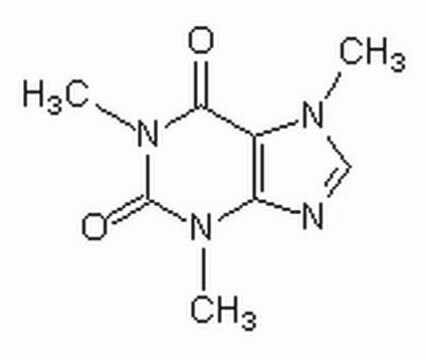W222402
Caffeine
anhydrous, 99%, FCC, FG
Sinónimos:
1,3,7-Trimethylxanthine
About This Item
Productos recomendados
origen biológico
synthetic
Nivel de calidad
grado
FG
Halal
Kosher
anhydrous
cumplimiento norm.
EU Regulation 1334/2008 & 178/2002
FCC
FDA 21 CFR 182.1180
Ensayo
99%
Formulario
powder
mp
234-236.5 °C (lit.)
solubilidad
H2O: soluble 18.7 g/L at 16 °C
aplicaciones
flavors and fragrances
Documentación
see Safety & Documentation for available documents
alérgeno alimentario
no known allergens
Organoléptico
odorless
cadena SMILES
CN1C(=O)N(C)c2ncn(C)c2C1=O
InChI
1S/C8H10N4O2/c1-10-4-9-6-5(10)7(13)12(3)8(14)11(6)2/h4H,1-3H3
Clave InChI
RYYVLZVUVIJVGH-UHFFFAOYSA-N
Información sobre el gen
human ... ADORA1(134) , ADORA2B(136) , ADORA3(140) , PDE4B(5142)
mouse ... Adora2b(11541)
rat ... Adora1(29290) , Adora2a(25369)
¿Está buscando productos similares? Visita Guía de comparación de productos
Categorías relacionadas
Descripción general
Aplicación
- Anti-hair loss effect of a shampoo containing caffeine and adenosine.: Discusses the efficacy of a shampoo formulated with caffeine and adenosine in reducing hair loss, underscoring caffeine′s role in enhancing hair follicle activity and promoting hair health (Chen et al., 2024).
Producto relacionado
Palabra de señalización
Warning
Frases de peligro
Consejos de prudencia
Clasificaciones de peligro
Acute Tox. 4 Oral
Código de clase de almacenamiento
11 - Combustible Solids
Clase de riesgo para el agua (WGK)
WGK 1
Equipo de protección personal
dust mask type N95 (US), Eyeshields, Faceshields, Gloves
Elija entre una de las versiones más recientes:
¿Ya tiene este producto?
Encuentre la documentación para los productos que ha comprado recientemente en la Biblioteca de documentos.
Los clientes también vieron
Nuestro equipo de científicos tiene experiencia en todas las áreas de investigación: Ciencias de la vida, Ciencia de los materiales, Síntesis química, Cromatografía, Analítica y muchas otras.
Póngase en contacto con el Servicio técnico





